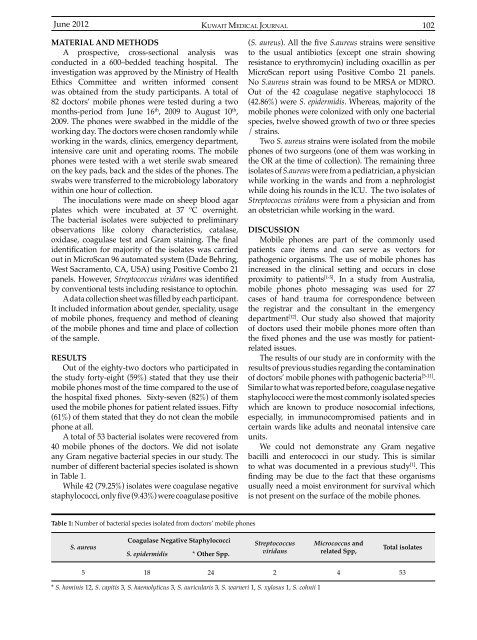Vol 44 # 2 June 2012 - Kma.org.kw
Vol 44 # 2 June 2012 - Kma.org.kw
Vol 44 # 2 June 2012 - Kma.org.kw
You also want an ePaper? Increase the reach of your titles
YUMPU automatically turns print PDFs into web optimized ePapers that Google loves.
<strong>June</strong> <strong>2012</strong><br />
KUWAIT MEDICAL JOURNAL 102<br />
MATERIAL AND METHODS<br />
A prospective, cross-sectional analysis was<br />
conducted in a 600–bedded teaching hospital. The<br />
investigation was approved by the Ministry of Health<br />
Ethics Committee and written informed consent<br />
was obtained from the study participants. A total of<br />
82 doctors’ mobile phones were tested during a two<br />
months-period from <strong>June</strong> 16 th , 2009 to August 10 th ,<br />
2009. The phones were swabbed in the middle of the<br />
working day. The doctors were chosen randomly while<br />
working in the wards, clinics, emergency department,<br />
intensive care unit and operating rooms. The mobile<br />
phones were tested with a wet sterile swab smeared<br />
on the key pads, back and the sides of the phones. The<br />
swabs were transferred to the microbiology laboratory<br />
within one hour of collection.<br />
The inoculations were made on sheep blood agar<br />
plates which were incubated at 37 ºC overnight.<br />
The bacterial isolates were subjected to preliminary<br />
observations like colony characteristics, catalase,<br />
oxidase, coagulase test and Gram staining. The final<br />
identification for majority of the isolates was carried<br />
out in MicroScan 96 automated system (Dade Behring,<br />
West Sacramento, CA, USA) using Positive Combo 21<br />
panels. However, Streptococcus viridans was identified<br />
by conventional tests including resistance to optochin.<br />
A data collection sheet was filled by each participant.<br />
It included information about gender, speciality, usage<br />
of mobile phones, frequency and method of cleaning<br />
of the mobile phones and time and place of collection<br />
of the sample.<br />
RESULTS<br />
Out of the eighty-two doctors who participated in<br />
the study forty-eight (59%) stated that they use their<br />
mobile phones most of the time compared to the use of<br />
the hospital fixed phones. Sixty-seven (82%) of them<br />
used the mobile phones for patient related issues. Fifty<br />
(61%) of them stated that they do not clean the mobile<br />
phone at all.<br />
A total of 53 bacterial isolates were recovered from<br />
40 mobile phones of the doctors. We did not isolate<br />
any Gram negative bacterial species in our study. The<br />
number of different bacterial species isolated is shown<br />
in Table 1.<br />
While 42 (79.25%) isolates were coagulase negative<br />
staphylococci, only five (9.43%) were coagulase positive<br />
(S. aureus). All the five S.aureus strains were sensitive<br />
to the usual antibiotics (except one strain showing<br />
resistance to erythromycin) including oxacillin as per<br />
MicroScan report using Positive Combo 21 panels.<br />
No S.aureus strain was found to be MRSA or MDRO.<br />
Out of the 42 coagulase negative staphylococci 18<br />
(42.86%) were S. epidermidis. Whereas, majority of the<br />
mobile phones were colonized with only one bacterial<br />
species, twelve showed growth of two or three species<br />
/ strains.<br />
Two S. aureus strains were isolated from the mobile<br />
phones of two surgeons (one of them was working in<br />
the OR at the time of collection). The remaining three<br />
isolates of S.aureus were from a pediatrician, a physician<br />
while working in the wards and from a nephrologist<br />
while doing his rounds in the ICU. The two isolates of<br />
Streptococcus viridans were from a physician and from<br />
an obstetrician while working in the ward.<br />
DISCUSSION<br />
Mobile phones are part of the commonly used<br />
patients care items and can serve as vectors for<br />
pathogenic <strong>org</strong>anisms. The use of mobile phones has<br />
increased in the clinical setting and occurs in close<br />
proximity to patients [1-5] . In a study from Australia,<br />
mobile phones photo messaging was used for 27<br />
cases of hand trauma for correspondence between<br />
the registrar and the consultant in the emergency<br />
department [12] . Our study also showed that majority<br />
of doctors used their mobile phones more often than<br />
the fixed phones and the use was mostly for patientrelated<br />
issues.<br />
The results of our study are in conformity with the<br />
results of previous studies regarding the contamination<br />
of doctors’ mobile phones with pathogenic bacteria [5-11] .<br />
Similar to what was reported before, coagulase negative<br />
staphylococci were the most commonly isolated species<br />
which are known to produce nosocomial infections,<br />
especially, in immunocompromised patients and in<br />
certain wards like adults and neonatal intensive care<br />
units.<br />
We could not demonstrate any Gram negative<br />
bacilli and enterococci in our study. This is similar<br />
to what was documented in a previous study [1] . This<br />
finding may be due to the fact that these <strong>org</strong>anisms<br />
usually need a moist environment for survival which<br />
is not present on the surface of the mobile phones.<br />
Table 1: Number of bacterial species isolated from doctors’ mobile phones<br />
S. aureus<br />
Coagulase Negative Staphylococci<br />
S. epidermidis * Other Spp.<br />
Streptococcus<br />
viridans<br />
Micrococcus and<br />
related Spp,<br />
Total isolates<br />
5 18 24 2 4 53<br />
* S. hominis 12, S. capitis 3, S. haemolyticus 3, S. auricularis 3, S. warneri 1, S. xylosus 1, S. cohnii 1
















